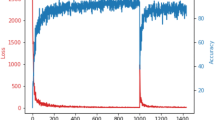Abstract
In this letter we investigate a neural network simplification schedule that takes place at the same time as regular weight adjustment and with variable pruning strength. The underlying connection model incorporates an explicit trainable factor modulating the classical synaptic weight. Learning in this context results in a reduced size structure with enhanced generalization ability. The effectiveness of the method is empirically explored in an artificial application and a classical real-world benchmark problem.
Similar content being viewed by others
References
Bengio, Y., Simand, P. and Frasconi, P.: Learning long-term dependencies with gradient descent is difficult, IEEE Transactions on Neural Networks, 51(2) (1994) pp. 157–166.
Box, G. E. P. and Jenkins, G. M.: Time Series Analysis, Forecasting and Control, Holden Day: San Francisco, CA, 1976.
Cotrell, M., Girard, B., Girard, Y. and Mangeas, M.: Time series and neural network: A statistical method for weight elimination, Proceedings of the International Symposium on Neural Networks, Brussels, (1993) pp. 157–164.
Fahlman, S. E. and Lebiere, C.: The cascade-correlation learning algorithm. In: D. S. Touretzky (ed.), Advances in Neural Information Processing System 2, Morgan Kaufmann: San Mateo, CA, (1990) pp. 525–532.
Izenman, A. J.: J. R. Wolf and the Zurich sunspot relative numbers, The Mathematical Intelligencer, 7(1) (1985) pp. 27–33.
Karmin, E. D.: A simple procedure for pruning back-propagation trained neural networks, IEEE Transactions on Neural Networks, 1(2) (1990) pp. 239–242.
KrishnaKumar, K.: Optimization of the neural net connectivity pattern using a back-propagation algorithm, Neurocomputing, 5(6) (1993) pp. 272–286.
Mozer, M. C. and Smokensky, P.: Skeletonization: A technique for trimming the fat from a network via relevance assessment. In: D. S. Touretzky (ed.) Advances in Neural Information Processing Systems 1, Morgan Kaufmann: San Mateo, CA, (1989) pp. 107–115.
Pi, H. and Peterson, C.: Finding the embedding dimensions and variable dependencies in time series, Neural Computation, 6(3) (1994) pp. 509–520.
Prechelt, L.: Connection pruning with static and adaptive pruning schedules, Neurocomputing, 16(1) (1997) pp. 49–61.
Reed, R.: Pruning algorithms — A survey, IEEE Transactions on Neural Networks, 4(5) (1993) pp. 740–747.
Rementeria, S. and Basogain, X.: Predicting Sunspots with a Self-Configuring Neural System, Proceedings of the Eighth Information Processing and Management of Uncertainty in Knowledge Based Systems Conference (IPMU 2000), Madrid, (2000) pp. 1184–1190.
Rementeria, S. and Olabe, X.: On Simultaneous Weight and Architecture Learning. In: J. Mira, R. Moreno-Diaz and J. Cabestany (eds.), Biological and Artificial Computation: From Neuroscience to Technology, Lecture Notes in Computer Science 1240, Springer Verlag, Berlin (1997) pp. 501–509.
Riedmiller, M. and Braun, H.: A direct adaptive method for faster backpropagation learning: The RPROP algorithm, Proceedings of the IEEE International Conference on Neural Networks, San Francisco, (1993) pp. 586–591.
Subba Rao, T. and Gabr, M. M.: An introduction to bispectral analysis and bilinear time series models, Lecture Notes in Statistics, Vol. 24, Springer Verlag, Berlin, 1984.
Wan, E. A.: Combining fossil and sunspot data: Committee predictions, Proceedings of the 1997 International Conference on Neural Networks (ICNN 97) (also accessible as http://www.ee.ogi.edu/~ericwan/PUBS/wan_icnn97b.ps), 1997.
Weigend, A. S., Huberman, B. A. and Rumelhart, D. E.: Predicting sunspots and exchange rates with connectionist networks. In: M. Casdagli and S. G. Eubank, (eds.), Nonlinear Modeling and Forecasting, Addison-Wesley, Reading, MA, (1992) pp. 395–432.
Williams, R. J. and Zipser, D.: A learning algorithm for continually running fully recurrent neural networks, Neural Computation. 1(2) (1989) pp. 270–280.
Author information
Authors and Affiliations
Rights and permissions
About this article
Cite this article
Rementeria, S. Dynamic Schedule for Effective On-Line Connection Pruning. Neural Processing Letters 14, 1–14 (2001). https://doi.org/10.1023/A:1011321906641
Issue Date:
DOI: https://doi.org/10.1023/A:1011321906641




